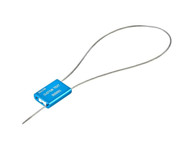Benefits of Using Cable Seals for Transport and Fuel Tank Terminals
Posted by Steve Diebold
Security-conscious oil and gas companies are increasingly adopting more stringent sealing procedures to prevent unauthorized access and the compromise of operational controls. Recently, the majority of petrochemical companies and businesses around the globe have opted for cable seals as their preferred securing mechanism due to their robust locking solution.
These seals serve to prevent unauthorized access or unintentional opening of critical valves, controls, tanks, and equipment at processing, storage, and loading sites. Furthermore, they deter tampering and theft by securely sealing bulk containers and tankers during transportation. These seals are in great demand for fuel and oil tank facilities as well as transportation purposes. Thankfully, American Casting & Manufacturing provides a wide range of cable seals in their product catalog, offering you various options to consider.
For many years, it was believed that a simple, reliable tamper indication seal would suffice for these sealing purposes. Frequently used were metal or plastic band seals. As complexity and risk increase, however, so do safety and security standards and procedures. Indicative seals are gradually being supplanted by security seals suppliers that are more robust and establish a physical barrier.
Oil industry risk and safety management recognize the majority of these safety aspects as potential threats to the security of corporate assets and personnel, as well as the general public. As a result, oil safety management implemented the pull-up cable closure, which is now extensively utilized in oil manufacturing facilities, as a more proactive measure to prevent accidents and fraudulent behavior. It has also been demonstrated that the sealing strength of pipelines used for transporting petroleum products can be enhanced by deploying cable seals in strategic locations.
Pull-up cable closures are available in two variants from AC&M. There are aluminum and steel cable seals with a range of cable diameters and strengths. Our inventory of cable seals ranges from the most fundamental (1/16" diameter) to the most secure (heavy-duty cable with ISO-17712 certification). In the majority of cases, these two are utilized to transport goods across international borders. Additionally, the cable length can be tailored to your specifications, and a variety of color options are available.
The durability of the CL-99 model's engraved letters and numerals on its steel body is a major selling point. In contrast, aluminum models are preferred because their bodies can be laser engraved with additional information, such as a bar code. In processing facilities and terminals, the most prevalent markings indicate whether valves are open or closed. The seal can be used as a "lockout" to prevent the valve from being adjusted unless it is first removed with a cutting instrument. Important control cabinets that contain switches or connections that must be protected from interference also contain seals. And even on the petroleum station's or other restricted area's doors or gates.
If petroleum and petrochemical containers are left unattended in high-risk areas for too long, they may be vandalized or stolen. Tankers are at risk if they must stop for even one hour. Instead of indicator seals, oil companies have begun installing cable seals or tamper-evident seals on tankers in regions where petroleum theft is prevalent. The vast majority of petroleum transporters in the United States make short-distance deliveries, so they are rarely exposed to danger. However, cable encapsulation is a prudent investment for long-distance petroleum product transport.
The cable insulation is also an excellent use for rail carriages. Unlike vehicles, rail tankers are frequently maintained for extended periods of time in isolated, high-risk locations. In addition, the quantity of goods in a rail car poses a grave risk if the car is opened by accident, tampered with by vandals, or stolen.
It is advantageous that cable seals for tankers can be installed swiftly and with minimal effort. However, it may be difficult to secure the valve or hatch on a tank vehicle or rail car because they are not standardized. The cable seals can be inserted readily into the corresponding holes in the hatches and valves. In uncommon instances, plastic security seals may be able to withstand pressure.
Theft protection for cleansed and conditioned empty containers or tankers is another possible application for cable seals. Using this method, you can verify that the tank's purity, allowable content, and condition are all in functioning order prior to filling it.
Contrary to prevalent belief, it is not difficult to select the proper cable seal. Nevertheless, there are a number of factors to consider, such as which seal best services your needs. Naturally, the needs of each individual user will vary. Important specifications include the length and girth of the cable, as well as the type of enclosure and labeling. You are not required to deal with this on your own. You can seek guidance from AC&M or use the information on our website to reach a conclusion.
Get in Touch With Us!
If you have any questions about our seals or would like more information on how to implement them in your petroleum or oil operations, please contact us. Many of the largest oil and gas companies in the world rely on AC&M's services. During normal business hours, you can discuss seal application services with a seasoned professional.
To contact a seal specialist at our corporate headquarters and manufacturing facility, please send an email to info@seals.com or call 1-866-304-4289 in the United States or 516-349-7010 internationally. Please visit www.seals.com if you are looking for a sales or service location outside of the US.

